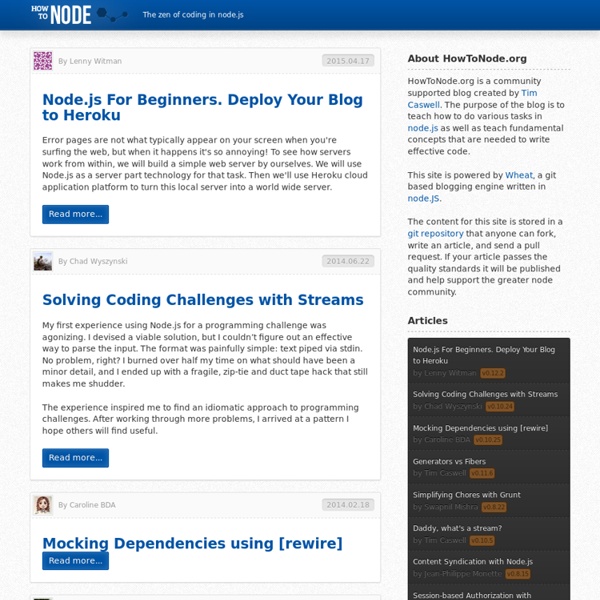



Pixel Ping Pixel Ping is a minimalist pixel-tracker written in CoffeeScript for Node.js. If you provide embeddable applications or HTML widgets for third-party sites, are serving them statically, would like to keep track of specific usage information, and don't want to inject something heavy like Google Analytics, perhaps Pixel Ping can help. The complete annotated source code is also available.
Formation Node.js Un monde nouveau Sorti en 2009, Node.js a complètement révolutionné la perception de JavaScript et des infrastructures logicielles côté serveur. Extrêmement performant, agréable à l’emploi, doté d’un écosystème et d’une communauté extrêmement vigoureux, Node.js affiche désormais de nombreux très gros acteurs en production avec des capacités de montée en charge insolentes et beaucoup de success stories. Objectifs La formation Node.js vous donne toutes les clés pour bien démarrer avec Node.js tout en professionnalisant et industrialisant vos pratiques de développement JavaScript.
Migrating from 2.x to 3.x · visionmedia/express Wiki Removed Changed req.header(field[, defaultValue]) replaced by req.get(field) (remains for backwards compatibility)res.header(field[, value]) replaced by res.set(field, value) / res.get(field) (remains for backwards compatibility)renamed app.register() to app.engine()template engine compliance from engine.compile(str, options) => Function to engine.
7 Free E-Books and Tutorials for Learning and Mastering Node.js OK, we won't bore you by telling you what Node.js is again or why it's so dang hot. You want to learn Node.js? There's no completely finished Node.js book out there that we're aware of. But there's one complete book in rough draft form, two partial guides and several other great resources for learning Node.js.
Developer's Guide (v1): Getting Started - Page Speed Online API - Google Code This document explains how to get started using the PageSpeed Insights API. Contents Introduction This document is intended for developers who want to write applications that can interact with the PageSpeed Insights API. PageSpeed Insights is a tool that helps developers optimize their web pages by analyzing the pages and generating tailored suggestions to make the pages faster. You can use the PageSpeed Insights API to programmatically generate PageSpeed scores and suggestions. Node Demo What is this thing? An online quiz system with realtime sync between the quiz server and connected clients (desktops, laptops, tablets, smartphones…) and an optional hardware interface. This is a wide-angle demo of Node.js capabilities, well-known modules, best practices, code patterns, etc. It was intended as the support of my Node.js talks at various conferences including BLEND, France.JS and tech·days. I also use it during my training classes for quiz running, because eh, it just works! Annotated source
Export This: Interface Design Patterns for Node.js Modules When you require a module in Node, what are you getting back? When you write a module, what options do you have for designing its interface? When I was first learning to work in Node I found the sheer number of ways to do things to be a bit overwhelming. JavaScript is extremely flexible and the community of developers contributing to open source seem to have different styles for implementing the same thing. On my journey with Node I've been keeping an eye out the Good Way to do things and adopting them for use in my own work and in our work at Good Eggs. In this post I'll share my observations of the Node module system and the ways in which you can use it to encapsulate and share code.
Let's Make a Web App: Nodepad Welcome to part 1 of Let’s Make a Web App, a new tutorial series about building a web app with Node. This series will walk you through building a web app with Node, covering all the major areas you’ll need to face when building your own applications. The app we’re going to build is a web notepad called Nodepad. Not particularly original, but well-defined and easy to understand. Selecting Frameworks and Tools Modern web applications depend on several components:
Create a Web App with Node.js - Boldr Create a Web App with Node.js Node.js is the new hype for server-side webish things. It's evented, non-blocking, fast and in javascript (not another language to learn, yay!). Real-Time Web is around the corner. Javascript means you can use existing JS librairies.
substack/stream-handbook Hosting Node.js and MongoDB After digging into web development with Node.js the last couple of months I had to choose where to host this blog, which I had decided to rewrite and run with Node as a result of my research. To be honest, I’ve been surprised there is no real ecosystem of (shared) hosting providers offering Node.js and MongoDB (which often is the obvious choice when developing a node application) on the cheap. There are some providers like nodejitsu for Node.js and mongolab for MongoDB - but there is no fully integrated experience as you would expect it coming from the LAMP world or even ASP.NET. So it seemed to be a Do-it-yourself-world. Challenge accepted! :-)
How do I get started with Node.js creationix/howtonode.org - GitHub nodeschool.io